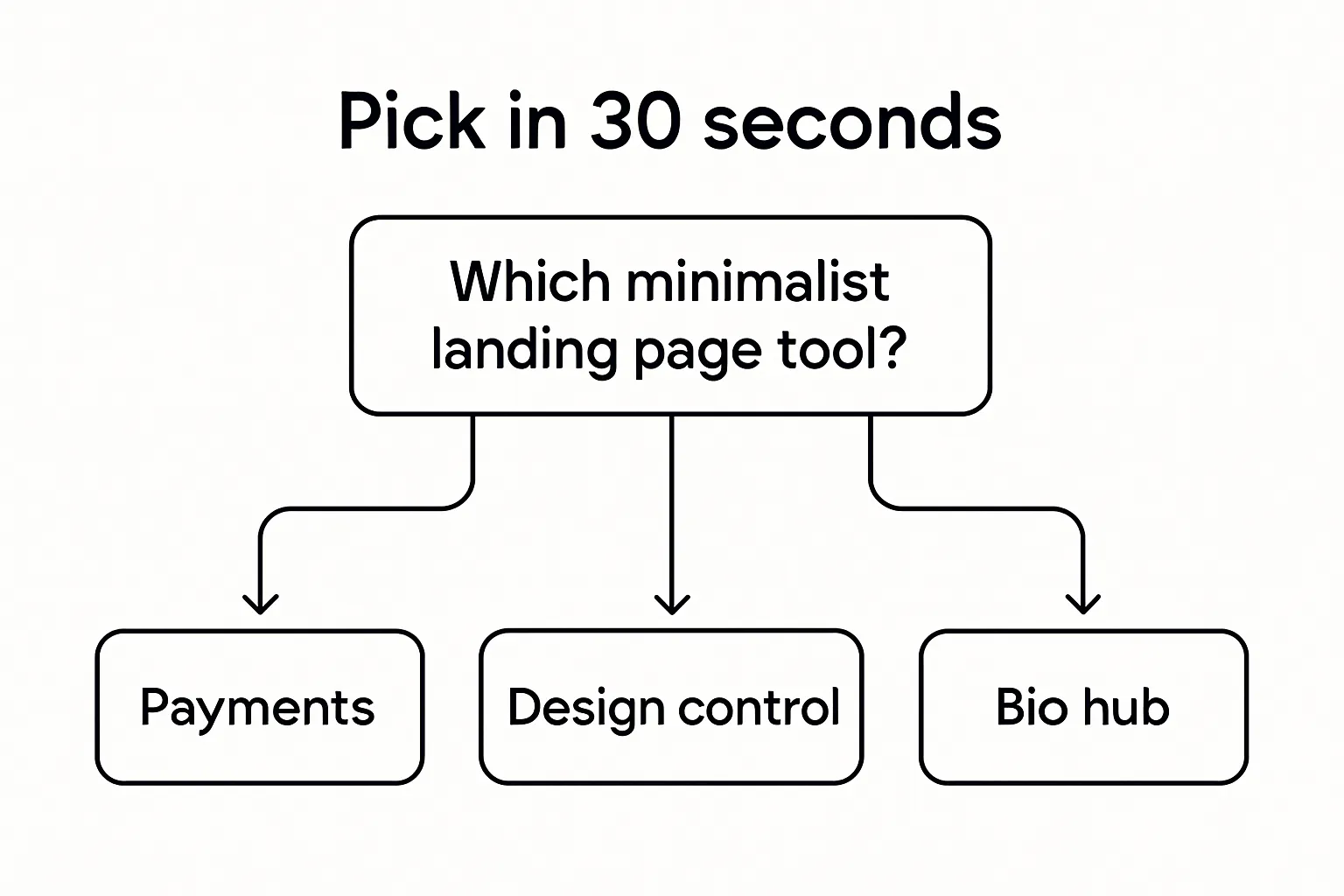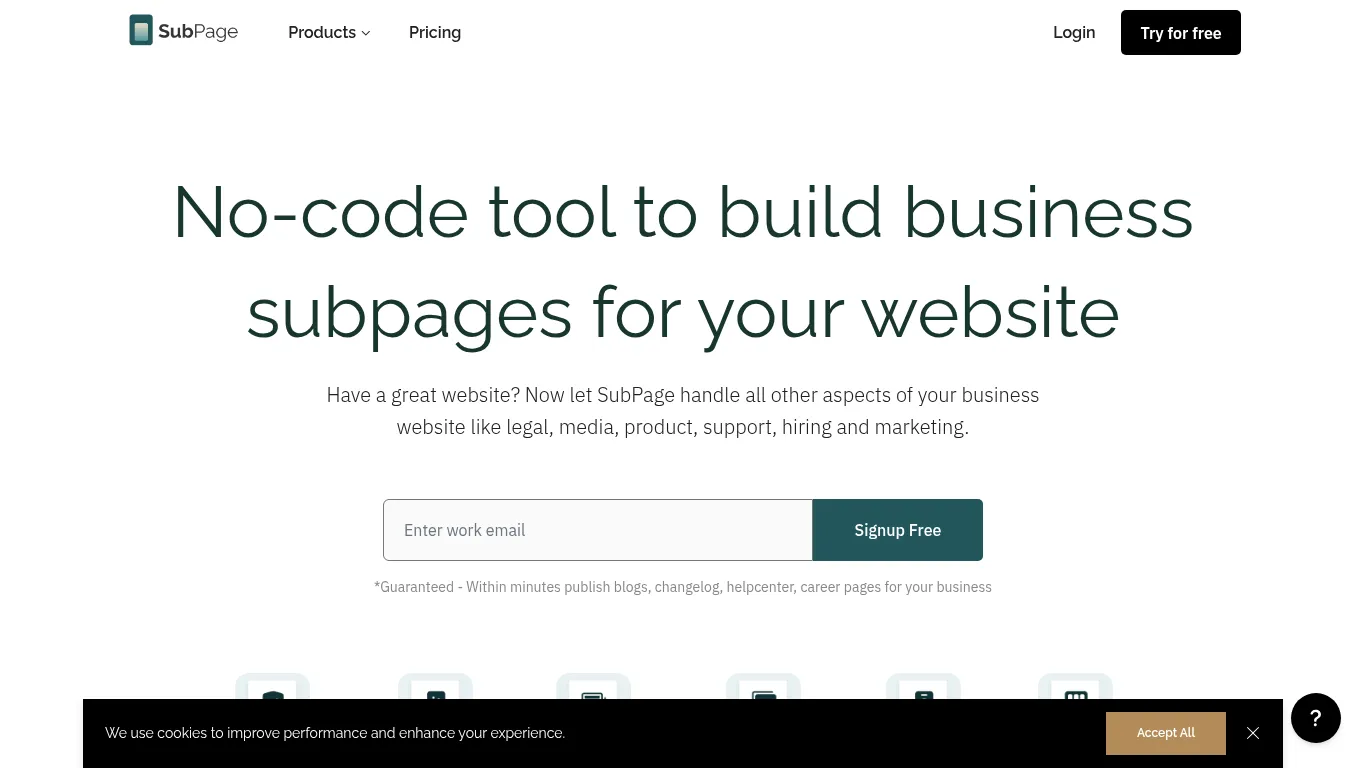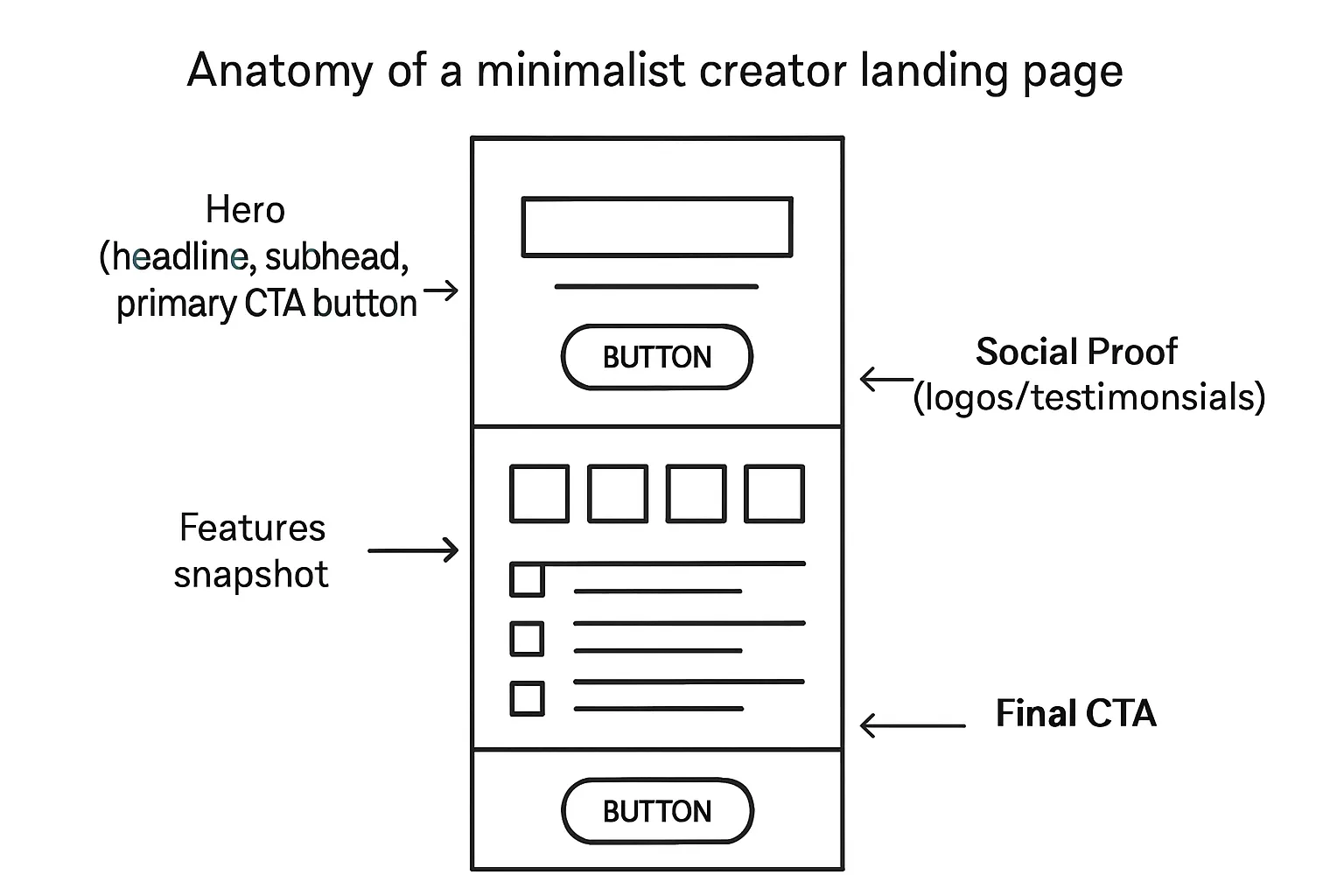Introduction + Subpage vs Carrd at a glance
Minimalist, no-code landing pages are having a moment in 2025. Creators need fast, focused pages that look good on mobile, load instantly, and make it effortless to collect leads, share links, or publish updates - without wrestling with a full website build.
Who this is for: creators, freelancers, indie makers, and small teams who want the shortest path from idea to live page - be it a personal bio, portfolio, link hub, or lightweight content pages like blog, help center, or careers.
TL;DR
Speed to publish: Need multiple lightweight pages (blog, help, careers) connected to your existing site? Choose Subpage.
Extreme simplicity: Want a one-page site or link-in-bio in minutes? Choose Carrd.
Customization: Prefer structured, brand-consistent layouts and built-ins (search, forms)? Subpage. Prefer ultra-minimal design with simple visual tweaks? Carrd.
Payments/checkout: Neither is a native checkout tool - expect link-outs or embeds.
Link-in-bio: Carrd.
Portfolios and simple one-pagers: Carrd. Content hubs and operational pages for your site: Subpage.
Feature-by-feature snapshot
Feature | Subpage | Carrd |
|---|---|---|
Editor style & learning curve | No-code, purpose-built editors per page type (blog/help/careers) with AI assist; very low learning curve | Very simple drag-and-drop with a minimal UI; near-zero learning curve |
Template variety & visual control | Professionally designed, brand-consistent layouts; opinionated structure for speed and consistency | Minimalist templates; light visual control (sections, fonts, colors) for single-page sites |
Forms, embeds, and lead capture | Built-in forms and widgets; search, feedback, and page-type specific features | Basic forms and embeds; works well for email capture or simple contact |
Payments/checkout | No native checkout; link out to payment processors or embed | No native checkout; link out to payment processors or embed |
SEO & performance basics | Fast by design; SEO helpers (e.g., SEO report for blogging) to keep pages optimized | Lightweight pages that load fast; basic SEO controls |
Pricing starters & domain support | Paid; integrates via DNS to live under your domain/subdomain | Free plan available; custom domains on Pro plans (annual pricing) |
Why this matters
Speed and simplicity aren’t just nice-to-haves - they directly impact conversions and ROI. The fewer steps between “I have something to share” and “it’s live and collecting leads,” the more momentum you keep. Lightweight pages that load fast and reduce friction typically see stronger engagement, especially on mobile, and make testing new ideas affordable.
"In 2020, Unbounce reported an average landing page conversion rate of 9.7% across industries." - Source
Who each tool is for (use-case fit)
Subpage: best-fit profiles
Creators needing ultra-fast setup for product teasers, waitlists, or simple sales pages
Users who want opinionated, minimalist layouts with enough brand control
One-tool workflows (link-in-bio + simple landing + lead capture)
Carrd: best-fit profiles
Portfolio, link-in-bio hubs, and ultra-light single-page sites
Beginners who value low cost and speed, with simple forms/embeds
Makers prioritizing clean aesthetics over complex features
Decision criteria to choose quickly
Do you need native payments vs external checkout?
How much design flexibility is enough?
Do you need multi-page scale or just one focused page?

Setup and learning curve
Onboarding and time-to-publish
Account creation, starter prompts, and sample templates: Both tools make signup fast. Subpage guides you with purpose-built page types (blog, help center, careers) and opinionated defaults that minimize choices. Carrd drops you into clean templates for one-page sites, ideal for bios, portfolios, or simple launches.
Typical build time from blank page to publish: Subpage excels when you need multiple lightweight pages connected to your site - often live in under 15 minutes. Carrd shines for single pages - link-in-bio or portfolio - often live in 5–10 minutes.

Editor experience
Drag-and-drop vs section-based editing: Subpage uses structured, section-based editors tuned for each page type, with helpful defaults and AI assist. Carrd uses a lightweight drag-and-drop approach with simple blocks.
Mobile preview and responsive controls: Both prioritize mobile; Subpage’s layouts are pre-optimized for consistency at scale, while Carrd’s minimal sections adapt well for single-page sites.
Undo/versioning, autosave, and draft flow: Subpage favors guided drafts and safe publishing flows; Carrd offers quick edits with straightforward save/publish actions.

Templates and starting points
Template categories (portfolio, launch, waitlist, sales, bio link): Subpage offers focused starters for content/ops pages (blog, help, careers, roadmap) plus simple landing pages and forms. Carrd provides minimalist templates perfect for bios, portfolios, and quick launches.
Quality vs quantity: how many you actually need to get live fast: A handful of well-structured templates usually beats a massive catalog. Subpage’s opinionated layouts reduce decision fatigue for multi-page setups; Carrd’s minimal set speeds up single-page publishing.
Design and customization depth
Subpage
Brand controls (colors, typography, spacing)
Unified brand settings applied across pages to keep a consistent minimalist look (colors, fonts, spacing, buttons).
Opinionated defaults reduce design choices so you can publish faster without breaking brand consistency.
Sections/blocks available; hero, features, pricing, FAQ
Purpose-built sections for common creator pages (hero, features, pricing, FAQs, testimonials, CTAs).
Page-type specific elements (e.g., HelpCenter search, Careers listings, Roadmap feedback) reduce reliance on add-ons.
Custom code options (CSS/JS) and embeds
Supports no-code widgets, forms, and tracking by design; lightweight embeds are straightforward.
Advanced CSS/JS customization may be limited by the platform’s opinionated patterns - great for speed and consistency, less for pixel-perfect tinkering.
Carrd
Theme-driven layout controls and constraints (great for consistency)
Clean, theme-based starting points that keep structure tight and pages fast-loading.
Ideal for minimal, single-page layouts where constraints help prevent over-designing.
Typography, color palettes, spacing knobs
Quick global tweaks for type, color, spacing, and buttons; enough to align with your visual identity.
Fine-grained layout control is intentionally minimal to preserve simplicity and responsiveness.
Custom embed support and visibility rules
Add embeds (video, audio, forms) and simple scripts for analytics or email capture.
Basic element controls (e.g., show/hide sections) keep pages focused without overwhelming options.
What creatives should check
Image handling (ratios, compression)
Confirm automatic image compression and responsive scaling to keep minimalist landing pages fast on mobile.
Icon sets and media blocks
Look for built-in icons, badges, and media blocks (video, audio, galleries) that fit your use case without custom code.
Reusability (duplicate sections/pages)
Ensure you can duplicate sections and pages to speed up experiments (A/B headlines, variant CTAs) and keep design consistent across launches.
Content, forms, and lead capture
Subpage
Native forms, field customization, and spam protection
Built-in, no-code forms with configurable fields, required validation, and lightweight anti-spam measures help you collect leads without plugins.
Email integrations (ESP/CRM basics) and webhooks
Connect via no-code widgets/embeds or pass data to your ESP/CRM through tracking and integration options; ideal for pushing contacts into automations.
File delivery or auto-responders for lead magnets (if available)
Pair Subpage forms with your email platform’s auto-responder to deliver ebooks/templates instantly; Subpage handles capture, your ESP handles fulfillment.
Carrd
Built-in form options (fields, required, styling)
Add concise forms with essential fields and simple styling so you can go live fast.
Sending to email or integrating via services (Zapier/ESPs)
Route submissions to your inbox or connect through Zapier/ESP integrations to trigger welcome sequences or add tags.
Using embeds for signups and calendars (e.g., Calendly)
Drop in embedded signup widgets, appointment schedulers, or simple checkout links to keep experiences lightweight.
Creator workflows to mirror
Lead magnet delivery (ebook, template)
Form → ESP automation (auto-reply with download link) → Tag/segment for nurture series.
Waitlist + confirmation sequence
Form (name/email) → Instant confirmation email → Drip updates until launch → Early access CTA.
Calendly consult bookings from a landing page
Short form (qualification questions) + embedded Calendly → Confirmation email with prep materials → Follow-up sequence.
Payments, ecommerce, and integrations
Subpage
Built-in vs external payment flows
Subpage focuses on page creation; payments are typically handled via external providers or embedded checkout widgets. Expect link-outs or inline embeds rather than a native cart.
Common stacks: Stripe/PayPal, Gumroad, Lemon Squeezy, or embeds
Use hosted checkout links or embed widgets from Stripe Checkout, PayPal buttons, Gumroad, Lemon Squeezy, or tip/donation tools.
Webhooks from your payment tool can notify your ESP/CRM for post-purchase automations.
Analytics: native vs Google Analytics/Meta Pixel setup
Subpage includes lightweight tracking; you can also inject Google Analytics and Meta Pixel to capture sessions, conversions (via thank-you pages or event snippets), and campaign UTMs.
Carrd
How to handle payments (external checkout links or embeds)
Carrd relies on external checkouts; add buy buttons or embed hosted checkouts for a seamless mobile flow. Most users link out from a clear CTA.
Typical creator stacks (Gumroad, PayPal buttons, Buy Me a Coffee)
Common patterns: Gumroad overlays/embeds, PayPal buttons for one-offs, Buy Me a Coffee for tips/memberships, and Stripe-hosted links for subscriptions.
Analytics and pixels (where to add, what to track)
Add GA and Meta scripts (Pro) in header/footer; track pageviews, outbound clicks, and conversion events (via embedded provider events or thank-you redirects). Use UTMs to attribute campaigns.
What to evaluate
Friction: in-page checkout vs redirect
Inline embeds can lift conversions on mobile; redirects are simpler but add steps. Test both on your top traffic source.
One-time purchases, donations, and subscriptions
Confirm your provider supports your primary monetization model (one-off sales, tipping/donations, recurring memberships) and currency needs.
Affiliate links and link tracking
Use UTMs or short links to attribute affiliate traffic; confirm your tool preserves UTMs through redirects and offers post-click analytics.
Performance, SEO, and accessibility
Speed and Core Web Vitals
Page weight, image optimization, and CDN usage
Keep pages lean: compress images (WebP/AVIF), defer non-critical scripts, and serve assets via a CDN to reduce latency.
Mobile-first rendering and animation impact
Favor simple layouts, avoid heavy animations, and use CSS transforms over layout-thrashing effects to keep CLS/LCP in the green.
SEO basics
Meta titles/descriptions, OG tags
Set clear titles and compelling meta descriptions; add Open Graph/Twitter tags for better link previews.
Clean URLs, sitemaps, indexing controls
Short, readable slugs; ensure canonical tags, generate sitemaps, and use robots/meta directives to control indexing.
Accessibility checks for creators
Color contrast, focus states, semantic structure
Meet WCAG contrast ratios, ensure visible focus rings, and use semantic headings for screen reader clarity.
Keyboard navigation and alt text support
Verify tab order and actionable roles; write concise, descriptive alt text for all non-decorative images.
Why it matters
Faster pages convert better and rank more consistently
"53% of mobile visits are abandoned if a page takes longer than three seconds to load." - Source
Pricing and value for money
Subpage pricing overview
Free vs paid tiers; custom domains and SSL
Primarily paid, with custom domains and SSL supported via DNS so pages live under your brand.
Traffic/hosting considerations and feature gates
Built-in search/forms/tracking included; feature access scales with page types and collaborators rather than raw traffic quotas.
Carrd pricing overview
Free plan caps; Pro Lite/Standard/Plus differences
Free: up to a few sites on Carrd-branded domains with core elements.
Pro tiers unlock custom domains, forms, embeds, and custom code.
Domains, forms, and advanced features by tier
Custom domains and advanced embeds/scripts require Pro; higher tiers add more sites and flexibility.
Cost vs outcome for creators
Minimal viable stack to capture leads and sell a first product
Subpage or Carrd + ESP (email) + hosted checkout (Stripe/Gumroad/Lemon Squeezy) is enough to launch.
Total cost of ownership when adding email, analytics, and payments
Email and payments are the main add-ons; both tools support GA/Meta pixels and UTMs for attribution, keeping costs focused on your ESP and payment provider.
Plan/Feature | Custom domain & SSL | Forms | Embeds & custom code | Payments approach | Analytics & pixels |
|---|---|---|---|---|---|
Subpage (typical) | Yes (via DNS integration) | Built-in forms with field controls | No-code widgets; lightweight embeds; custom scripts as allowed | External providers (Stripe/PayPal/Gumroad/Lemon Squeezy) via links/embeds | Built-in tracking; add GA/Meta pixels |
Carrd Free | No (Carrd subdomain) | Basic form options limited | Limited embeds; no custom code | External checkouts via links | Basic page stats; pixels typically not available |
Carrd Pro Lite | Yes | Forms enabled | Simple embeds; limited scripts | External checkouts via links/embeds | Add GA; basic pixel support |
Carrd Pro Standard | Yes | Full form fields and controls | Embeds + custom code (header/footer) | External checkouts via links/embeds | GA + Meta pixels supported |
Carrd Pro Plus | Yes | Advanced forms across multiple sites | Expanded embeds/scripts and site limits | External checkouts via links/embeds | Full tracking scripts across sites |
Best-fit use cases and examples
Subpage shines when
Launching a waitlist or simple product pre-sell
Running time-bound promos (countdowns, limited offers)
You want a single tool for lead capture + simple sales page
Carrd shines when
Building a personal portfolio or link-in-bio hub
Rapidly publishing minimalist one-pagers on a budget
Embedding multiple external services with a clean layout
Example page outlines (swipeable)
Portfolio/creator bio hub
Hero with tagline + headshot, concise bio, social links, featured work grid, primary CTA.
Product teaser + waitlist
Teaser hero, benefits bullets, animated countdown (optional), waitlist form, social proof logos.
Simple sales page with testimonials
Hero with offer + price, feature highlights, testimonial carousel, FAQ, checkout CTA.

Migration, workflows, and stacking with your content engine
Moving from Carrd to Subpage (or vice versa): domain mapping, redirects, and content porting checklist
Prep and inventory
Export copy, images, icons, and embed codes (forms, checkout, analytics, pixels).
List all URLs, CTAs, and success/thank-you pages; capture screenshots for reference.
Domains and DNS
Decide on structure (root, subdomain, or path). For Subpage, map via DNS; for Carrd Pro, connect custom domain.
Configure A/CNAME records and set SSL; verify HTTPS canonicalization (www vs non-www).
Redirects and URL hygiene
Create 301s from the old URLs to new ones; preserve UTMs where possible.
Update canonical tags, OG/Twitter cards, and sitemap; submit to search consoles.
Content porting
Rebuild sections (hero, benefits, social proof, FAQ, CTA) and migrate alt text and headings structure (H1–H3).
Reconnect embeds (forms, checkout widgets) and reapply visibility rules.
Tracking, consent, and compliance
Move GA/Meta/other pixels; re-map goals/conversions to the new thank-you URLs.
Set cookie consent where required and confirm GDPR/CCPA wording.
QA and launch
Test mobile/Lighthouse performance, forms, payments, and email automations.
Crawl for broken links; verify 301s and analytics events before switching DNS.
Connecting forms to your email tool and automations
Field mapping and tagging
Map fields (name, email, custom intents) and standardize list tags (e.g., “Waitlist-Q3”, “Lead-magnet-ebook”).
Deliverability and consent
Use double opt-in where appropriate; add consent checkboxes and plain-language microcopy.
Automations
Waitlist: immediate confirmation → prelaunch drips → launch-day CTA.
Lead magnet: instant delivery email → nurture sequence → offer.
Consult bookings: form qualifier → embedded scheduler confirmation → reminders and prep materials.
Webhooks and enrichment
Send submissions to your CRM; append UTMs/referrer; trigger Slack/CRM tasks for high-intent leads.
How to pair your minimalist landing page with a blog/SEO engine for growth (introduce BlogBowl)
Stack strategy
Top-of-funnel: publish SEO content on a fast, structured blog while your minimalist landing page captures demand.
Mid-funnel: embed relevant posts, FAQs, and comparison snippets into landing pages to reduce friction.
Conversion: use in-post CTAs driving to waitlists, demos, or simple sales pages.
Why BlogBowl
Launch a professional blog in ~60 seconds with SEO-optimized, fast-loading templates.
Automate keyword research, daily article creation, internal linking, and embedded media.
Built-in newsletter and privacy-friendly analytics unify your content and audience growth.
Flexible domain options let you run blog.example.com or example.com/blog alongside your landing pages.
When to add a changelog or help center to support your launch momentum (BlogBowl fit)
Changelog
Add when you begin shipping frequent updates; it builds trust, surfaces momentum, and creates fresh crawlable content.
Cross-link from landing pages to features you’ve shipped; add RSS or email digests via BlogBowl’s newsletter tools.
Help center
Add once you have recurring questions or a beta cohort; it reduces support load and ranks for long-tail queries.
Structure articles around “how-to” and “troubleshooting,” then link contextually from your landing pages and onboarding emails.
Operational benefits
With BlogBowl, run blog + changelog + help center under one roof, keep branding consistent, and track performance in one analytics view.
Final verdict: Which one should you choose?
If you want the fastest path to a focused landing page with lead capture and simple selling, pick Subpage. It’s opinionated, fast to brand, and great when you need multiple lightweight pages (blog/help/careers/roadmap) orbiting your main site.
If you need the most budget-friendly, minimalist one-pager or link hub with clean embeds, pick Carrd. It’s perfect for portfolios, link-in-bio hubs, and quick single-page launches.
Matrix recap: speed-to-publish, customization, payments, SEO, price
Speed-to-publish: Carrd for single-page speed; Subpage for multi-page speed (blog/help/careers) via consistent, structured editors.
Customization: Subpage offers brand-consistent, structured sections; Carrd offers simple theme controls for minimalist layouts.
Payments: Both rely on external providers (Stripe/PayPal/Gumroad/Lemon Squeezy) via link-outs or embeds.
SEO: Both can be fast and mobile-friendly; Subpage adds helpful SEO guidance for content pages.
Price: Carrd wins for the lowest-cost one-pagers; Subpage trades a higher price for built-in features and multi-page scale.
Next steps and 30-minute build plan
Define your goal: email capture, waitlist, or simple sales (choose one CTA).
Pick a starter template aligned to your goal (bio hub, teaser, or sales).
Draft essentials: a concrete headline, 3 benefit bullets, a single CTA.
Add social proof (logos or 1–2 short testimonials) and a short FAQ.
Connect your form to your ESP; confirm the thank-you page and auto-response.
Add your payment/checkout link or embed, plus GA/Meta tracking.
QA on mobile: readability, tap targets, load speed; publish and share with UTM-tagged links.
Note for scaling content
If your landing page starts to rank or you’re ready to grow organic traffic with a blog, docs, and updates, pair it with BlogBowl to automate publishing, SEO, and analytics while keeping your site stack simple. BlogBowl launches a professional blog in under a minute, automates keyword research and internal linking, ships AI-written articles and media, and includes built-in newsletter + privacy-friendly analytics - so you can focus on shipping and selling.


